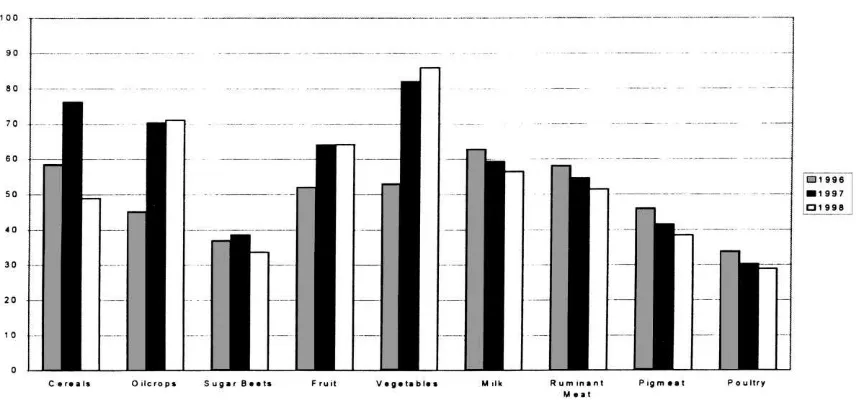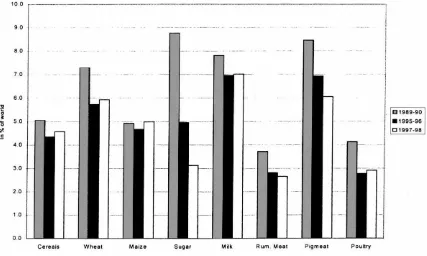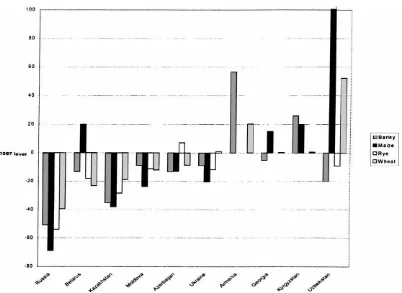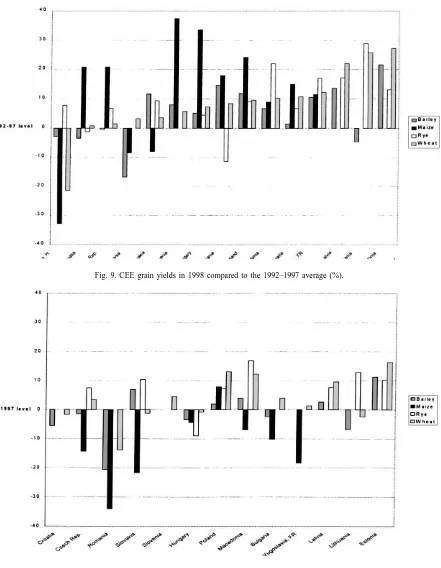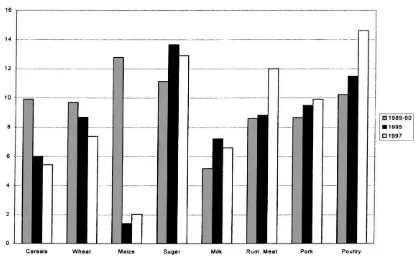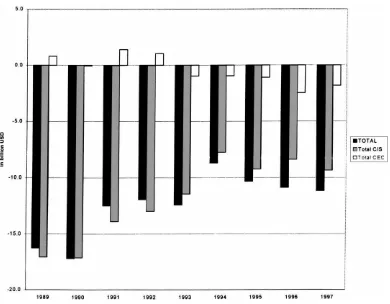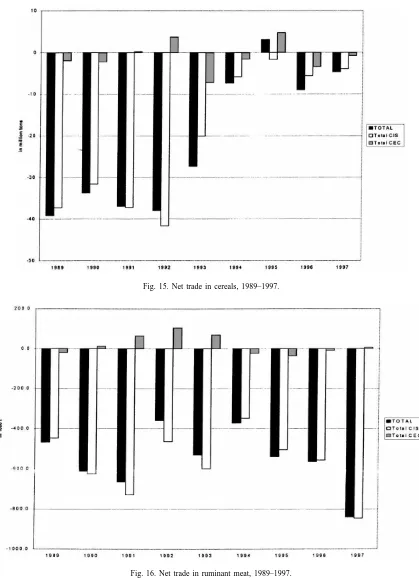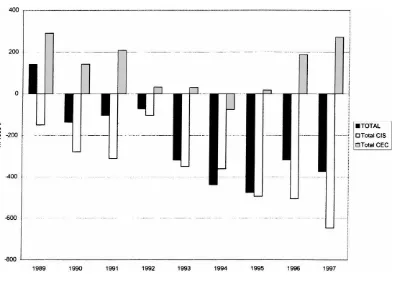Agricultural Economics 22 (2000) 37–54
Agricultural reforms in Central and Eastern Europe and the former
Soviet Union
Status and perspectives
qC. Csaki
1∗Lead Agriculture Advisor, The World Bank, 1818 H Street NW, Washington DC, USA
Received 8 January 1998; received in revised form 27 April 1998; accepted 16 August 1999
Abstract
The current status of the agricultural sector in Central and Eastern Europe and the former Soviet Union is described, in the context of reforms undertaken during the transition from a centrally planned economy to a market-based one. Sectoral performance is analyzed, focussing especially on general trends in production, and emerging trading patterns. Five critical basic elements of reform are described, and a table is presented rating each country in the study on progress in completing each type of reform. Overall conclusions are presented, indicating that in each basic element of reform, the CEE countries have achieved considerably more success than those of the CIS. The paper concludes with a discussion of prospects for development in the region. ©2000 Elsevier Science B.V. All rights reserved.
Keywords: Food and agriculture; CEE; CIS; Transition; Reform process
1. Introduction
The agrarian economies of Central and Eastern Eu-rope (CEE) and the former Soviet Union are under-going a systemic change and transformation. Look-ing back, it can be seen that the countries concerned made the right choice in setting their overall goals and policies for transition to a market economy. Un-der the present economic and political conditions in the region, there is no alternative to the creation of
q
Based on a presentation made at the Eighth Annual World Agri-cultural Outlook Conference, Japan International Research Center for Agricultural Sciences, Tsukuba, Japan, 27–29 May, 1999.
∗Corresponding author. Tel.: +1-202-458-2546; fax: +1-202-477-6391
E-mail address: [email protected] (C. Csaki)
1Professor of Agricultural Economics, Budapest University of
Economic Sciences, Hungary.
a market economy based on private ownership. How-ever, given the developments of the past eight years, it is clear that the initial expectations for transformation were overly optimistic and the transition process is far more complicated and complex than anyone imag-ined in 1990–1991 (Csaki and Lerman, 1997b). The region’s agrarian economy is still struggling to adjust to economic reality.
While there is no ‘blueprint’ for adjusting agricul-tural policies to the market economy, it is possible to determine certain salient features and strategic behav-ior that are conducive to effective transitions based on the experiences of countries further along in the transition process. This paper provides an analysis of the status of agricultural reforms in the region, sup-plemented with an update of the regional agricultural situation in 1997–1998. The analyses are based on statistics processed by FAO for each of the individual
38 C. Csaki / Agricultural Economics 22 (2000) 37–54
Fig. 1. CIS production as a percentage of the 1989–1991 average.
countries, and also on the results of analytical work be-ing done with the support of the World Bank. It needs to be acknowledged, however, that there are ques-tions of reliability and consistency between the statis-tical information from all countries mentioned in the report.
2. Sectoral performance in the region
The agrarian economy of the region has been char-acterized in the 1990s by a considerable fall in pro-duction. The years 1996, 1997, and 1998 have not re-sulted a in significant change in sectoral performance from earlier in the decade:
• Between 1990 and 1996, the share of GDP produced
in agriculture at the regional level fell by an annual average of 7.8%. The decline of agricultural GDP was greater than in the rest of the economy and, as a result, the share of agriculture in total GDP fur-ther declined both, in the Commonwealth of Inde-pendent States (CIS) and CEE to 9.4% and 8.5%, respectively.
• The decline in agricultural production continued in
1997–1998 in most of the CIS countries. Russia, Kazakhstan, and Ukraine experienced exceptionally poor harvests in 1998. The output of all major prod-ucts remained significantly below the pre-reform
levels (Fig. 1). There are, however, signs of recov-ery in crop production, especially for fruits and veg-etables. At the same time, the outputs of all major livestock products continue to decline, indicating a deepening crisis in the livestock sector in the CIS countries.
• In contrast to the CIS, the signs of output
stabi-lization can be observed in the CEE countries. In most cases, this stabilization occurred at 70–80% of the pre-reform levels, while in Estonia, Latvia, and Croatia, current production appears to have stabi-lized at 50% of pre-reform output (Fig. 2).
• The output of major crop products was close to, or
somewhat below, pre-reform levels in 1997–1998 in CEE countries (Fig. 3). There is no indication of returning to pre-reform levels of output for the live-stock sector, with the exception of poultry, where the output has surpassed pre-reform levels for 1997 and 1998.
C. Csaki / Agricultural Economics 22 (2000) 37–54 39
Fig. 2. CEE agricultural production indexes (1989–1991 = 100).
Fig. 3. CEE production as a percentage of 1989–1991 average.
that the overall performance of the CEE countries has also remained below world averages (Fig. 6).
The development in yields basically confirms the assessment provided above. In the CIS countries, there is a declining trend in major grain yields. The decline is especially significant in those countries which lag behind in agricultural reforms, namely,
40 C. Csaki / Agricultural Economics 22 (2000) 37–54
Fig. 4. Production of ECA transition countries in comparison to world production.
Fig. 5. Production of CIS as a percentage of world production.
Agricultural technology levels did not improve in 1997–1998 in any measurable way. For the region as a whole, the use of agricultural inputs remained, more or less, at the level of previous years, which is only about 15–20% of pre-reform levels. An upward trend can only be observed in CEE countries.
The changes in regional agricultural trade continued during 1996–1997:
• Despite the decline in production, the region’s
C. Csaki / Agricultural Economics 22 (2000) 37–54 41
Fig. 6. Production of CEE as a percentage of world production.
Fig. 7. CIS grain yields in 1998 compared to 1992–1997 (%).
• In some countries, there has been a considerable
change in the composition of agricultural trading partners. The region’s agrarian trade determined by the Council of Mutual Economic Assistance
col-42 C. Csaki / Agricultural Economics 22 (2000) 37–54
Fig. 8. CIS grain yields in 1998 compared to 1997 (%).
lapse of traditional markets and failure to develop alternatives.
• However, while the structure of the region’s
agricul-tural exports and imports has changed considerably as a result of declining consumption, the balance of agricultural trade for the region as a whole did not deteriorate. Overall, the region continues to be a net importer of agricultural products. The negative bal-ance of the CIS countries has been reduced. In the CEE an increase in the negative agricultural trade balance can be observed (Fig. 14).
• The structure and source of imports and exports
have also changed. Perhaps the most significant structural change is that the CIS countries, and Rus-sia in particular, have become one of the world’s biggest meat importing regions. In place of the mas-sive grain imports characteristic of the Soviet pe-riod, Russia now mainly buys meat. This is quite clearly a more favorable solution from an economic viewpoint, since the large quantity of grain pur-chased in earlier decades by the Soviet Union was
used in animal husbandry with very low efficiency. At the same time, the CIS countries are increas-ingly appearing on world markets as grain exporters (Figs. 15–17).
• The role of Central and Eastern Europe in the
world ruminant meat trade has diminished, while the region strengthened its position in trade in dairy products and their pork exports have recovered to pre-reform levels in 1996–1998. Additionally, in recent years, the CEE region’s significance on grain markets has increased somewhat (Figs. 15–17).
• Another important change is the growth in the
im-portance of quality processed products in the re-gion’s agrarian trade and, together with this, in the share of the developed countries, especially the Eu-ropean Union and the USA in the region’s food im-ports.
• Sales within the region continue to be of great
stan-C. Csaki / Agricultural Economics 22 (2000) 37–54 43
Fig. 9. CEE grain yields in 1998 compared to the 1992–1997 average (%).
44 C. Csaki / Agricultural Economics 22 (2000) 37–54
Fig. 11. CIS and CEE transition countries’ agricultural trade as a percentage of world trade.
C. Csaki / Agricultural Economics 22 (2000) 37–54 45
Fig. 13. CEE agricultural trade as a percentage of world trade.
46 C. Csaki / Agricultural Economics 22 (2000) 37–54
Fig. 15. Net trade in cereals, 1989–1997.
C. Csaki / Agricultural Economics 22 (2000) 37–54 47
Fig. 17. Net trade in pork, 1089–1997.
dards within the region. Some of the countries of Central and Eastern Europe are having increasing success on the markets of the developed countries, but, for the majority of countries in the region, sell-ing within the region remains practically the only possible direction for the export of their agricultural produce, often in the form of special barter deals. On the whole, the region’s agrarian trade is becom-ing steadily integrated into the agrarian trade of the world and the European region. This process is most advanced in the case of the countries of Central and Eastern Europe, where the CEFTA offers further pos-sibilities for regional co-operation. In the great ma-jority of the countries concerned, a liberal agrarian trade policy is also assisting in the integration of the countries of the region into world agrarian markets. Most of the countries in the Central and East Euro-pean region are members of the WTO, or their ad-mission is pending. The obligations accompanying the anticipated EU membership for most of these coun-tries are also having a growing influence on their trade policy.
The agrarian trade policy of the CIS countries is changing and is a source of considerable uncertainty in the medium-term. The voices of those demanding increased protection of internal agrarian markets are becoming louder in the CIS countries, and especially in Russia. A proposal has also been elaborated for the introduction of a considerably projectionist ‘Common CIS Agrarian Trade and Support Policy’, similar to that of the European Union. It is not yet possible to clearly foresee the outcome of these processes, but it seems likely that the agrarian trade policy of the CIS countries will shift towards growing protectionism unless the protracted entry of Russia and Ukraine to the WTO sets limits to this unfavorable change.
3. What stage has the reform process in agriculture reached in the region?
48 C. Csaki / Agricultural Economics 22 (2000) 37–54
• the removal of direct government intervention
from agricultural markets and the creation of a market-compatible policy framework for the agrar-ian economy;
• the privatization of land and transformation of the
inherited farming structure;
• the de-monopolization and privatization of food
processing and the trade in agricultural produce and capital goods;
• the creation of a functioning rural financial system;
and
• the establishment of the institutional structure and
system of public administration required by market economies.
There has been little difference between one country and another in terms of what needs to be done. How-ever, there are fairly large differences when it comes to the pace of realization and the manner of imple-mentation. Our analysis intentionally emphasized ‘on the ground’ results as opposed to pure policy reforms (which are often legislated, but not implemented). The results of the analysis are summarized in Tables 1 and 22:
Our analysis for 1998 indicates a further differen-tiation among CEE and CIS countries in the pace of agricultural reform:
• In the leading CEE countries, the reform process is
close to completion. The possibility of EU mem-bership has accelerated reforms in those countries that were lagging somewhat behind the leading EU accession candidates (Csaki, 1996), most notably in Lithuania and Latvia. Romania and Bulgaria, un-fortunately, have shown only modest advancement. The agriculture policy agenda in the CEE is charac-terized by efforts to complete the transition, to cope with the increased social problems in rural areas, and to adjust to the evolving CAP. Unfortunately, the task of facilitating increased competitiveness has
2The description of the status of reforms for each country was
compiled by the World Bank staff most familiar with that country’s agricultural policies. Numerical ratings were then assigned to each of the five reform categories in accordance with the criteria listed in Table 2. These ratings were then revised in several review sessions to improve consistency of rankings. An earlier version of this analysis was presented in Csaki and Lerman, 1997b. The criteria for rating the price and trade policies were slightly modified in April 1999, however, the comparability with the 1997 results has been maintained (Csaki and Nash, 1997; Csaki and Fock, 1999).
often been stymied by farm lobby demands to pro-vide immediate protection in the agricultural sector and to provide income transfers to farming popula-tions;
• There has not been any significant progress in
agri-cultural reform in the core countries of the CIS. In Russia, Ukraine and Kazakhstan, this standstill in the reform process has contributed to the further decline in agricultural output. Some of the smaller countries in the CIS, such as the Kyrgyz Repub-lic, Moldova, and Azerbaijan, however, have taken significant steps in 1998 to continue reforms in the agricultural sector. In 1998, Tajikistan, Turk-menistan, Uzbekistan, and Belarus had still not started any significant reforms.
The major conclusions of the overall review are as follows:
• The reform process is considerably more
compli-cated and complex that anyone had originally ex-pected.
• The results of the reforms have not yet met original
expectations. The relatively rapid growth of produc-tion that characterized the Chinese reforms has not occurred. Transformation of the economic structure proved to be a far more complex task. This is due, largely, to the incomplete application of the basic element of farming, the private family farm. To a large extent the inherited large-unit structure has survived the changes.
• The pace of transformation of the agrarian sector
and the rural economy is lagging behind the rate of changes in the economy as a whole.
• Surprisingly, the biggest transformation has taken
place in the price and market environment, while there is a substantial lag in solving the financing problems of agriculture and in the area of institu-tional reforms.
• There are very considerable differences in the
re-form perre-formances of the individual countries. Due to the adoption of more comprehensive transition policies, the CEE countries are quite clearly far more advanced than the CIS countries.
• The transformation of agriculture is most advanced
princi-C. Csaki / Agricultural Economics 22 (2000) 37–54 49
Table 1
Status of agricultural reforms in CEE and CIS countries in April 1999 (1997)a,b
Country Market conforming trade Land Agroprocessing and Rural Public institutional Total and price policy reform input supply finance framework score
Hungary 9 (9) 9 (9) 10 (9) 9 (8) 8 (8) 9.0 (8.6)
aAn explanation of the numerical ratings is given in Table 2. (1 = centrally planned economy, 10 = completed market reforms). bSource: World Bank estimates.
pally in the area of the institutional system and in the financing of agriculture, but land reform, and the transformation of the inherited economic structure, is still unfinished in practically all of these coun-tries.
• The transformation of agriculture in the CIS
coun-tries is still in its early stages. Distortions continue in the production, pricing, and marketing of ‘strate-gic’ products, and the system of institutions and in-struments of the planned economy has not yet been fully dismantled.
Many valuable conclusions can be drawn from the analysis of the experiences of the countries leading in the transformation. The following can be stated:
• The general economic upswing can greatly assist
the agricultural reforms. The greatest progress has been made in transformation of the sector by those
countries where the general economic recovery has also begun.
• Development in the non-agricultural segment of the
rural economy is of key importance for the recovery of agriculture. In the great majority of the countries that are the most advanced in the reforms, it has been the upswing of the rural economy surrounding agriculture that has made possible a substantial re-duction in the numbers of people employed in agri-culture, and at the same time, an improvement in the efficiency and competitiveness of agriculture itself.
• An important factor in the successes achieved in
re-forms is consistency, and the combined implemen-tation of parallel steps in areas related to the re-forms.
• The greatest reform progress has been made by
50 C. Csaki / Agricultural Economics 22 (2000) 37–54
Table 2
Key to numerical ratings used in Table 1a
Market conforming trade and price policy
Land reform Privatization of agropro-cessing and input supply
Rural financial sys-tems
Public institutional framework
1–2. Direct state control of prices and markets.
1–2. System dominated by large-scale farms.
1–2. Monopolistic state owned industries.
1–2. Soviet type sys-tem, with ‘Agrobank’ as the sole financing channel.
1–2. Institutions of command economy.
3–4. Deregulation with in-dicative prices, and price con-trols; significant NTB on im-ports or exim-ports. zation and mass privati-zation in design of early implementation stage.
3–4. New banking regulations are intro-duced; little or no commercial banking.
3–4. Modest restruc-turing of government and public institu-tions.
5–6. Mainly liberalized mar-kets constrained by the ab-sence of competition and some remaining controls on trade policy.
5–6. Advanced stage of land privatization, but large-scale farm restruc-turing is not fully com-plete.
7–8. All command econ-omy type interventions are removed. Market and trade policies are in compliance with WTO, however, domes-tic markets are not fully de-veloped.
7–8. Most land privatized, but titling is not finished and land market not fully functioning.
7–8. Majority of indus-tries privatized with a framework conducive for with market conforming trade and agricultural policies.
9–10. Farming structure based on private owner-ship and active land mar-kets.
9–10. Privatized agro- in-dustries and input sup-ply, with improved inter-national competitiveness.
9–10. Efficient finan-cial system for agri-culture, agro-indus-tries, and services.
9–10. Efficient pub-lic institutions fo-cused on the needs of private agriculture.
aSource: World Bank estimates
steps, despite the great difficulties that these efforts are causing in the short-term. In most cases, the ap-peals for a gradual approach appear to be a sign of the lack of will; this is especially the case in the CIS countries.
In all countries, the process of agricultural reforms has been strongly influenced by day-to-day politics. Very often, politics has been, and still is, determining the pace and extent of reforms, at the expense of eco-nomic rationality. In general, there is a lack of care-fully considered, long-term strategies, and an objec-tive and realistic evaluation of the economic conse-quences of the different possible solutions. As a re-sult, the negative economic consequences of the trans-formation are greater than the unavoidable minimum, even in the most advanced countries (Csaki, 1995).
The situation in the different main areas of transfor-mation covered in our analysis has been summarized in the following.
3.1. Creation of a market conforming trade and price policy environment
Practically all countries (with the exception of a few CIS countries) have taken major steps in this direction.
• In Central and Eastern Europe, the macro-economic
C. Csaki / Agricultural Economics 22 (2000) 37–54 51
that methods directly serving efficiency and com-petitiveness are increasingly coming to the fore in the system of agricultural supports.
• State intervention remains strong in the CIS
coun-tries, in both, the price formation and trade pol-icy. In these countries, despite the frequently pro-claimed direct support for agriculture, the agrarian sector suffers serious losses due to the price pol-icy and trade restrictions (especially export controls and taxes) separating it from world markets. Calcu-lations show that the balance of the different inter-ventions is negative for agriculture. It would appear that governments are trying to make agriculture con-tinue to bear the burden of providing cheap food for the urban population. The growing intervention of regional authorities in the functioning of the agri-cultural sector is a relatively new phenomenon. This can be observed particularly in Russia and Ukraine.
3.2. Privatization of land, reorganization of the large farm units
Land reform and land ownership continues to be the subject of heated debates in practically all countries of the region.
• In the countries of Central and Eastern Europe, the
privatization of land based on some form of com-pensation is largely approaching completion. The new farm structure is characterized by a varied mix of small and large units. The remaining pieces of the state owned units from the socialist period are also increasingly undergoing change and adapting to market economy conditions. The legal settlement of land ownership relations is not yet completed, and the land register and the emergence of a mar-ket for land are still in the initial stages. In a few countries, a heated debate is being conducted on the ownership of land by companies and foreign nation-als.
• While land has formally passed into private
own-ership in the decisive part of the CIS countries (Russia, Ukraine, Belarus), the large-scale farm-ing sector remains practically untouched. The co-operatives and state farms have been transformed into share companies (Brooks and Lerman, 1994; Csaki and Lerman, 1996, 1997a). However, in prac-tice, there has been no change in the real questions
of substance. These large units continue be con-trolled by a central management structure and oper-ate with low efficiency and face increasing financial problems. The role of independent private farming is marginal, not least of all because of the deterrent effect of the undeveloped market relations. There has been remarkable progress in Moldova and Azer-baijan in 1998 in the transformation of the Kolkhoz system (Csaki et al., 1998). Radical land reforms have been carried out in only a few countries of the former Soviet Union, as a consequence of their spe-cial political and economic situations. This is the case for Armenia and Georgia where independent private farming now dominates. Here, the distribu-tion of land carried out on the basis of family size resulted in very small farm sizes and this has gone together with a steep decline in agricultural produc-tion for the market. Conversely, in some CIS coun-tries (Uzbekistan and Tajikistan) private ownership of land is prohibited by the constitution and the lease hold arrangements are an added uncertainty.
3.3. Privatization of the food industry and of trade in agricultural produce and capital goods for agriculture
Formally, substantial progress has been made. How-ever, the food industry, which is technologically back-ward and incapable of quality production, is one of the biggest obstacles to the further development of agri-culture in the region.
• In Central and Eastern Europe, with the exception
of the Baltic states, privatization of the agricultural environment has been carried out in keeping with the principles of privatization in general, and for the most part is nearing completion. A lag can be observed in Romania, Bulgaria and the countries of ex-Yugoslavia. A special case is Hungary, which, as a result of the liberal privatization process, now has perhaps the most developed food industry of the region, due also in considerable part to substantial foreign investment.
• The CIS countries opted for what, on the whole, is
52 C. Csaki / Agricultural Economics 22 (2000) 37–54
given to agricultural producers, giving them major-ity ownership of these branches, on special terms or entirely free of charge. Contrary to expectations, this solution did not result in new, well capitalized owners and more favorable conditions for agricul-tural producers. In fact, the technological decline of the food industry accelerated and, because of the complicated ownership structure, it became ex-tremely difficult to involve foreign capital. Further steps and the renewed settlement of ownership are required to set the food industry on its feet. Instru-ments for this could be new liquidation procedures and support for new investments. Unfortunately, the widespread bureaucracy and corruption in the CIS countries seriously obstruct both, the further trans-formation and the establishment of new plants and small businesses.
3.4. Agrarian financing
This is one of the most critical areas for the agrarian sector in the region.
• In the CEE countries, after intensive preparations
and a lengthy transitional period, the financing of agriculture has improved considerably since 1994, although the new private institutions are manageri-ally weak and financimanageri-ally vulnerable. This is the re-sult, partly of the reforms implemented in the bank-ing system, and partly of the credits extended by the gradually recovering food industry and the agrar-ian trade and capital goods supply. Finally, the cre-ation of an agriculture-oriented rural banking sys-tem has also been progressing, resulting in the estab-lishment and increasingly active operation of agri-cultural credit co-operatives and financial institutes specializing in rural areas.
• In the great majority of CIS countries, there is
prac-tically no functioning rural financial system sim-ilar to that in developed countries. The inherited banking system continues to provide financing for large plants using the accustomed methods of the earlier period (state credit, financing the supply of produce for state stocks), but there are practically no provisions at all for the financing of the private sector. The beginnings of a system of agricultural credit co-operatives have appeared in the countries most advanced in the transformation of
agricul-ture, namely Armenia, Georgia and, recently, also Moldova, and the credits extended by the process-ing industry are also growprocess-ing.
3.5. Institutional reforms
Transformation of the institutional structure is pro-ceeding more slowly than practically all other areas of reform throughout the region.
• Institutional reforms have accelerated in CEE since
1995, stimulated by the challenges of EU acces-sion. Despite these tangible developments, the in-stitutional system of agriculture requires substantial further transformation in these countries. In addition to the modernization and reform of state adminis-tration, further qualitative development is required in practically all areas of the institutional systems for market agriculture, including consulting, train-ing, and research (see also European Commission, 1997).
• Apart from minor changes, the institutional system
of the former centrally planned economy continues to operate in the CIS countries and continues to act as a serious curb on the transformation of the sec-tor. Due to the general economic recession, there are fundamental disorders in the operation of the institutional system and the underpaid and unmo-tivated state bureaucrats strive to supplement their incomes through corruption. Training and research centers are suffering from severe financial problems and in some countries they receive no financial sup-port from the government budget.
4. The prospects for development in the region
func-C. Csaki / Agricultural Economics 22 (2000) 37–54 53
tion of this, on the internal demand for agricultural produce.
In many CEE countries, the process of sector trans-formation will probably be completed within the next four or five years. This, in itself, will improve the con-ditions for directly determining agricultural produc-tion and, together with the anticipated acceleraproduc-tion of general economic development, could lead to the sta-bilization of food production, more efficient produc-tion, and a greater upswing driven by potential com-parative advantages. Although the effect of EU acces-sion cannot be clearly quantified, it will probably give further stimulus for the growth of production in the countries concerned.
It is far more difficult to predict changes in the CIS countries. It seems probable that further difficult years lie ahead for the sector in this region, compounded by the struggle between conservative and progressive forces. The reforms will probably continue to advance only slowly. However, it is not likely that the decline in production will continue. The results of 1996–1998 and the forecasts for 1999 indicate that the fall in the region’s agricultural output has reached its lowest point. In the short-term, the most likely course is mod-erate growth alternating with stagnation. Substantial growth in production can only be expected if substan-tive progress is made in the reforms that directly de-termine the factors of production. This will probably happen only in the medium-term.
Many studies have forecast development in the re-gion for the medium term (5–10 years) as a subset of global projections.3 These calculations, and our anal-ysis of the progress of sectoral reforms, suggest the following:
• In the CEE countries, development can be expected
to follow a production course close to or higher than the world average. For a few products this trend could be even more favorable.
• In the CIS countries, the probable course of
devel-opment will be more modest, and probably below the world average. Naturally, in this group of coun-tries there will be exceptionally large differences between the individual countries. Trends at region level will obviously be determined by the results in
3See (Agriculture Canada, 1996; European Commission, 1997;
FAO, 1997; FAPRI, 1997), Nurul (1995), (OECD, 1997; USDA, 1994).
Russia and Ukraine where, in our judgement, the conditions for a bigger upswing will probably not be created until the final stage of the forecast period in the best of cases.
• In general, crop production will begin to expand
sooner than animal husbandry. In some countries, especially Ukraine and Kazakhstan, the ecological and technical potential is there for a quick recov-ery in the crop sector, mainly in grain production. Such a quick recovery, however, assumes the imme-diate implementation of appropriate sector reforms, which in our view do not appear very likely.
• In Central and Eastern Europe, animal husbandry
will probably continue to stagnate while in the CIS countries it is highly likely that the decline will continue for most of the period under analysis.
• The increase in quality demands will probably
out-pace reconstruction of the food industry. In general, it can be said that the backward food industry could restrict the growth of produce output for a relatively long time to come.
• The difficulties of the transformation and the
prob-lems of the food industry will probably strengthen the protectionist trends in the CIS countries. How-ever, it is to be hoped that consumer interests will prevent any serious restriction of imports.
In the case of grains, a performance around the level of full self-sufficiency can be expected, with a small volume of exports likely in better years and smaller net imports when weather conditions have been un-favorable. Only minor shortfalls are likely for wheat, while there will probably be a few million tons of sur-plus maize, mainly from the output of the Central Eu-ropean countries. The region will probably remain a moderate importer of sugar, with the CEE probably regularly producing a small surplus and the CIS coun-tries a deficit of 2–3 million tons a year. There will be a constant surplus on the milk market in the Central European countries but substantial net imports can be expected for the CIS countries. In the case of beef and
mutton, both CEE and the CIS will probably remain
al-54 C. Csaki / Agricultural Economics 22 (2000) 37–54
though diminishing, demand on the markets of the CIS countries.
Considering the main products, the prospects for the region as a whole are that the net imports will fall slightly even if the forecast moderate general growth of agriculture is realized. However, the region as a whole will continue to be a net food importer. It would appear that exploitation of the very considerable nat-ural resources of the region will remain in the more distant future and that, up to the year 2010, the region will not become a substantial source for satisfying the growing global food demand. Naturally, because of differences in the production levels of the individ-ual countries and in the pace of reforms, differences within the region will grow.
References
Agriculture Canada, 1996. Medium term baseline projections 1996. Ottawa.
Brooks, Karen, Lerman, Zvi, 1994. Land reform and farm restructuring in Russia. World Bank Discussion Paper 327. Washington, DC.
Csaki, Csaba, 1995. Where is Agriculture Heading in Central and Eastern Europe? Agricultural Competitiveness. Dartmouth, NH. Csaki, Csaba, 1996. Agriculture related issues of EU enlargement to Central and Eastern Europe. Society Economy in Central and Eastern Europe 17 (1), 35–46.
Csaki, Csaba, Nash, John, 1998. The agrarian economies of Central and Eastern Europe and the Commonwealth of Independent States: situation and perspectives, 1997. World Bank Discussion Paper 387. Washington, DC.
Csaki, Csaba, Fock, Achim, 1999. The agrarian economies of Central and Eastern Europe and the Commonwealth of Independent States: an update on status and progress, 1998, World Bank ECSSD Enivronmentally and Socially Sustainable Development Working Paper 13. Washington, DC.
Csaki, Csaba, Lerman, Zvi, 1997a. Land reform in Ukraine: the first five years. World Bank Discussion Paper 371. Washington, DC.
Csaki, Csaba, Lerman, Zvi, 1997b. Land reform and farm restructuring in East Central Europe and CIS in the 1990s: expectations and achievements after the first five years, European Rev. Agric. Economics 431–455.
Csaki, C., Lerman, Z., 1996. Agricultural transition revisited: issues of land reform and farm restructuring in East Central Europe and the Former USSR. Quarterly J. Internat. Agric. 35 (3), 211–240.
Csaki, Csaba, Lerman, Zvi, Moroz, Victor, 1998. Land reform and farm restructuring in Moldova: progress and prospects. World Bank Discussion Paper 398. Washington, DC.
European Commission, 1997. Agenda 2000. Brussels.
FAPRI, 1997. International Agricultural Outlook. Iowa State University/University of Missouri. Columbia, MO.
FAO, 1997. The State of Food and Agriculture, 1996. Rome. Nurul, Islam (Ed.), 1995. Population and Food in the Early
Twenty-First Century. International Food Policy Research Institute. Washington, DC.
OECD, 1997. The Agricultural Outlook, OECD. Paris.
